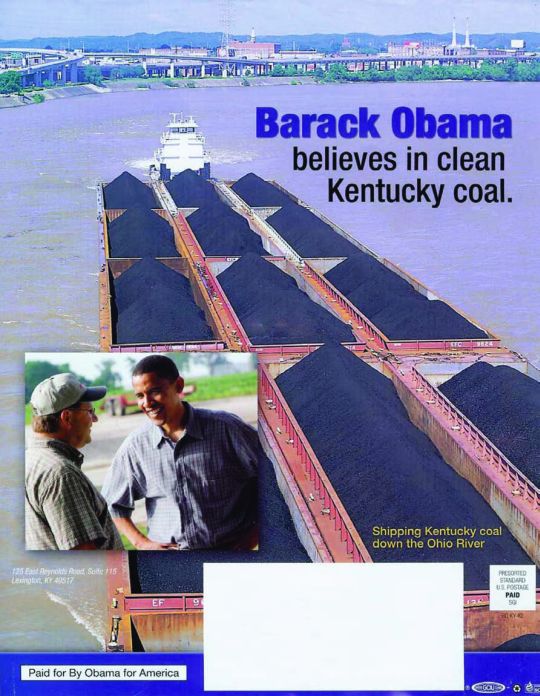 Obama for clean Kentucky coal
Obama for clean Kentucky coal
Hillary Clinton has been pilloried for pandering to working class voters with her gas-tax holiday proposal. But she’s not the only one telling working-class voters what they want to hear.
“Barack Obama believes in clean Kentucky coal.” So reads a direct mailer being distributed in Kentucky ahead of the state’s May 20 primary. (Click the image to the right for a larger version.)
Clark Stevens, press secretary for the Obama campaign in Kentucky, confirmed that the mailer came from the campaign. “Yes, it is an official mailer,” he said.
Does Obama really believe in “clean Kentucky coal”?
“Clean coal” typically refers to coal burned in Integrated Gasification Combined Cycle (IGCC) plants with operational carbon capture and storage (CCS) facilities to bury the plant’s greenhouse-gas emissions underground. There are no IGCC plants in Kentucky, and no operational CCS facilities. Technically, there is no “clean Kentucky coal.”
There is one IGCC plant proposed for the state, but it hasn’t yet broken ground. Most experts predict that widescale carbon sequestration is still a decade away (PDF).
The Obama campaign has made it clear that they want no new coal plants in the meantime. Jason Grumet, a top Obama energy adviser, told Grist that “the policies we have already articulated make [coal plants without CCS] economically unrealistic.” He went further on a recent panel sponsored by the Society of Environmental Journalists:
[Obama] is confident … that his carbon cap program … will make it absolutely ludicrous to even contemplate any type of coal, new coal, that is not 100 percent sequestered. … if he is unable to get that carbon policy in place quickly, that he will do whatever is necessary to prevent the siting of a new generation of pulverized coal facilities, including setting [emission] standards that would be essentially a moratorium …
Given that CCS is a decade away, it follows that Obama’s policies would amount to a suspension of commercial coal-plant construction for the duration of his term, whether it’s four or eight years, excluding publicly funded demonstration projects like FutureGen. That would allow for little growth in Kentucky coal, unless it started shipping its coal overseas (as of 2006, 80 percent — $2 billion worth — was exported [clarification: “exported” to other states, not overseas]).
Meanwhile, Obama may believe in clean Kentucky coal, but many residents of the state are more familiar with the dirty kind. According to activists on the ground, strip-mining “is turning Eastern Kentucky into a despicable latrine.” Hundreds of mountains have been leveled, leaving poverty and unemployment in their wake. The number of jobs created in Kentucky by coal has dropped by 60 percent in the last 15 years.
As Kentucky resident Erik Reese reported in Grist, studies in the state have found that children there suffer from “an alarmingly high rate of nausea, diarrhea, vomiting, and shortness of breath — symptoms of something called blue baby syndrome — that can all be traced back to sedimentation and dissolved minerals that have drained from mine sites into nearby streams. Long-term effects may include liver, kidney, and spleen failure, bone damage, and cancers of the digestive tract.”
There’s a difficult conversation to be had with voters in coal states like Kentucky about the fate of coal and the steps political leaders can take to help coal communities through the coming transition. For the moment, at least, Obama seems unwilling to have that conversation.


